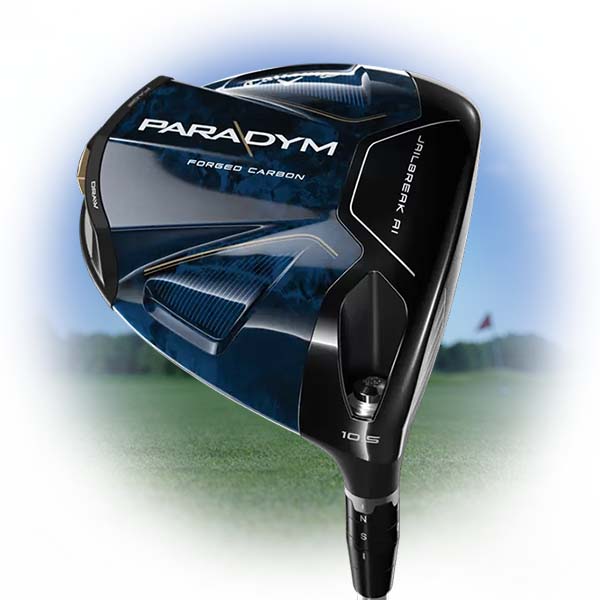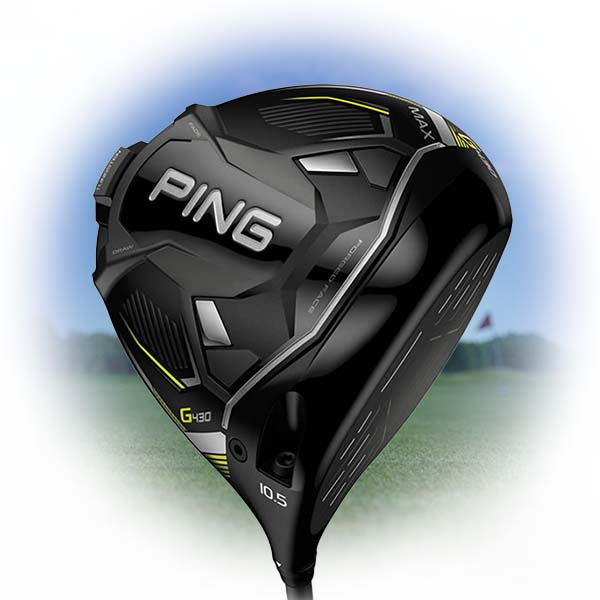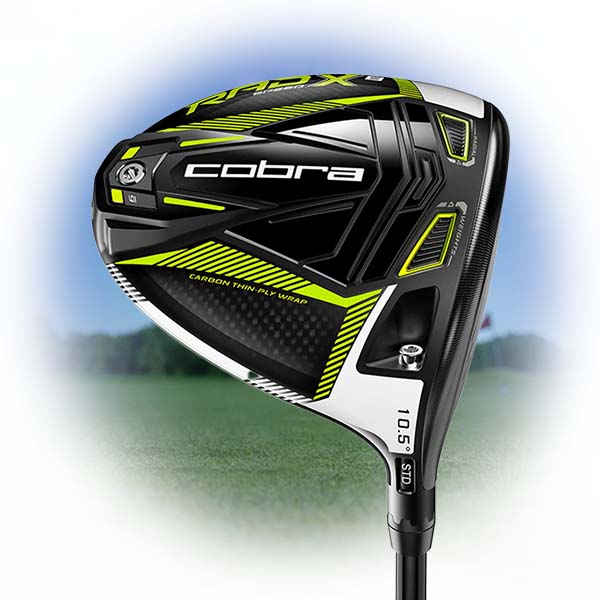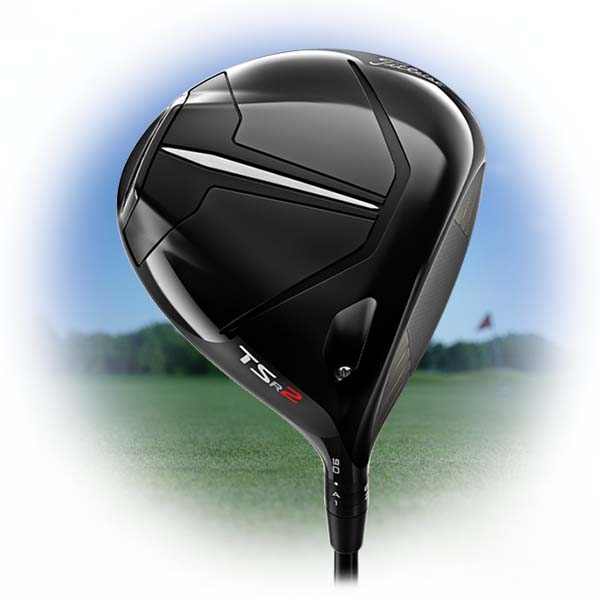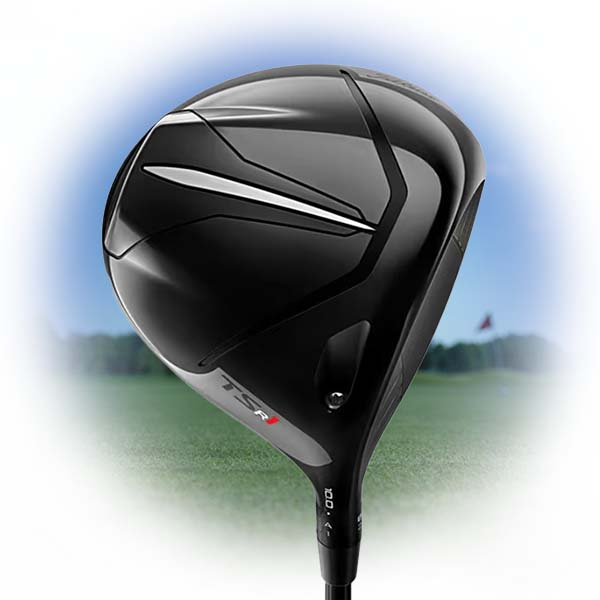Click To Share
Most of us need a little help off the tee but the good news is that modern drivers are designed with us in mind and made to maximize distance and forgiveness.
I took a look at dozens of drivers and I think the best driver for high handicappers is the Callaway Paradym.
But that’s not the only option out there for you, here’s my breakdown of the best golf drivers for high handicappers…
1. Callaway Paradym
The Paradym is the latest and greatest from Callaway and if it’s within your budget might be the best combination of length and forgiveness on the market today.
From all my testing this year, the Paradym was the clear winner in terms of both forgiveness and distance. This is the club I put in my own bag.
This driver will soon be at the the top of our list of the Most Forgiving Drivers (as soon as it’s updated)
In terms of looks, I usually prefer a more traditional looking club at address, but the blue crown of the Paradym didn’t bother me at all. It’s not obscenely large like some clubs designed for high handicappers, and its almost symmetrical.
My previous gamer was a Titleist and even being used to their very traditional designs, this was a pleasure to hit.
Ok, now on to the important stuff…
Callaway Paradym Specs
- Lofts: 9°, 10.5°, 12° (Adjustable -1°, +1°, 0° and +2°)
- Lie: 57° (adjustable from -1° to +2°)
- Head Size: 460cc
- Swing Weight: D3
- Adjustable Hosel: Yes
- Adjustable Weights: Yes (15g Sliding Weight)
- Stock Shafts:
- Aldila Ascent PL Blue 40 Graphite
- Project X HZRDUS Gen 4 Silver 50 Graphite
- Project X HZRDUS Gen 4 Silver 60 Graphite
- Project X HZRDUS Gen 4 Black 60 Graphite
- Fujikura Ventus TR Blue 6 Graphite
Usually forgiveness is somewhat difficult to test with a human, but it was clear from using this club with a launch monitor that my off center hits were far better than with other drivers. I was legitimately impressed with how forgiving this club was.
Usually, the most forgiving clubs don’t give you the best ball speed on center hits, but that was surprisingly not the case here. I was getting a little more ball speed and distance than my current driver that was fitted for me.
Pros
- High MOI and lots of forgiveness
- Great ball speed off the face
- Not ugly
There are three bits of tech in this club that make all this happen (according to Callaway).
The first is a 360° Carbon Chassis. Callaway uses no titanium in the body of the Paradyn giving them extra weight to position for ball speed and stability.
Second is the new Jailbreak system. It’s 33% lighter than the previous version while still adding ball speed to off-center strikes. Finally, Callaway continues to use AI to design their club faces. This makes them faster across all strikes and tightens dispersion.
This clubs also has sliding weight in the rear that will help promote either a fade or draw. It’s not going to completely cure a bad slice (only a swing change will do that) but it will help you make small adjustments to your ball flight to maximize distance.
2. Ping G430 Max
The G430 has made some obvious improvements in forgiveness and holds its own with the other (more well-known) drivers on this list at a lower price point.
Ping is one of those companies that quietly produces some top-level gear without the advertising fanfare of some of the other companies. The Ping G425 is one of those clubs that I haven’t heard much about but is hard to ignore.
Ping G430 Max Specs
- Lofts: 9°, 10.5°, 12°
- Lie: 58.5° (adjustable from -1° to +2°)
- Head Size: 460cc
- Swing Weight: D3
- Adjustable Hosel: Yes (-1.5° to +1.5° loft)
- Adjustable Weights: Yes (25g rear movable)
- Stock Shafts:
- PING Alta CB Black 55 (56g, 57g, 60g)
- PING Tour 2.0 Chrome 65 (56g, 61g, 66g)
- PING Tour 2.0 Black 65 (60g, 66g)
- Mitsubishi Kai’Li White 60 (65g, 66g)
- HZRDUS Smoke Red RDX 50 (50g, 51g)
- HZRDUS Smoke Red RDX 60 (60g, 61g)
It also has a rear weight (26g) but the G425 gives you the option to move the weight to change the club to have either a draw, fade, or neutral bias. This makes it a great option for those of you that want maximum forgiveness and distance but also tend to hit the ball relatively straight.
One of the best features of the G425 has nothing to do with club technology and that is the price. You can usually find it for less money than some of the other drivers on this list.
Like almost all the clubs on this list, you aren’t going to see a lot of improvement over the previous years’ models on sweet spot hits. But you will see a decent difference on off-center hits. The G425 is more forgiving than its predecessors.
When I hit the club, I compared it to the G410 and I did see about a 5% improvement on off-center hits. Of course, this wasn’t scientific testing…just a handful of swings on a launch monitor, but noticeable nonetheless.
3. Cobra RADSpeed XB
The RADSpeed XB is designed specifically for high handicappers with a high launch, low spin, and lots of forgiveness. With a recent price drop, it’s a great bargain too.
Perhaps you’re the type of player who is looking to upgrade the driver in your bag, but don’t necessarily want to break the bank to do so. We would encourage you to consider the Cobra RADSpeed driver.
The RADSpeed XB is the model in the RADSpeed lineup that has a bigger footprint and more weight towards the rear which makes it more forgiving and has a higher launch. It also features an internal weight pad positioned low and back to promote higher launch and straighter ball flights.
Higher handicappers probably should avoid the “regular” RADSpeed driver as it is less forgiving than the XB.
One thing to be aware of with this club is that it is louder than most. Whether or not you like that is more of a personal preference thing than it is related to actual driver performance. But I have heard some golfers say that a louder sound makes them feel confident hitting the driver and makes them swing smoother because they don’t feel the need to kill it to get that big sound.
Like most of the clubs on this list, this one is also adjustable so you can get a pro to help you dial in the right settings to maximize your distance and help to correct some ball flight issues.
4. Titleist TSR2
The TSR2 seems like a bigger evolution of Titleist’s driver lineup than usual. It feels and looks great and delivers distance and forgiveness as well.
If you prefer a more classic look but still want the forgiveness and technology to help your game then Titleist may be the perfect fit for you. They have a long history of sticking to more traditional-looking clubs but as of late have been keeping up with the other big names in terms of game improvement technology.
The TSR2 is the latest Titleist driver that is specifically designed for golfers that are less consistent with their face contact.
According to Titleist they employed something called a “Multi-Plateau Variable Face Thickness design” that is supposed to boost golf ball speed for contact all across the face. The result is that you’ll see less ball speed loss when you miss the sweet spot of the driver.
Titleist TSR2 Specs
- Lofts: 8°, 9°, 10°, 11° (same for left-handed)
- Lie: 58.5° (adjustable from -.75° to +1.5°)
- Head Size: 460cc
- Adjustable Hosel: Yes
- Adjustable Weights: No
- Stock Shafts:
- HZRDUS RED CB 50g, 60g
- HZRDUS Black 4G 60g, 70g, 80g
- Mitsubishi Tensei AV Blue 55g, 65g, 75g
- Mitsubishi Tensei 1K Black 65g, 75g, 85g
The other major change in the TSR lineup (and specifically the TSR2) is the clubhead shape design.
Titliest claims they have improved the aerodynamics of the club head. This should mean that the reduced air resistance helps you generate more clubhead speed.
What that actually means in terms of MPH is difficult to say but even just an increase of 1 MPH can give you an extra 2-3 yards off the tee. That may not seem like much but if you start averaging 2-3 more yards every time, that can have a positive impact on your scrore.
The other aspect of the new shape is that Titleist was able to make these aerodynamic changes while also making the club look more traditional at address. This is certainly a personal preference, but I have always felt that the classic looking clubs are less distracting when you address the ball before a shot.
My experience with the TSR2 was very positive. Using a launch monitor I was consistently getting solid results in terms of distance compared to the other clubs I tested. This club was right up there with the top pick above so it really comes down to personal preference.
Pros
- Great ball speed even on mis-hits
- Classic look makes you feel confident at address
- Adjustable hosel has many options
Cons
- Very expensive
- Only a minor upgrade from the previous TSi2
The most noticeable differences were on shots where I missed the center of the clubface where this club outperformed the others as well, which is why it is my top pick for high-handicap golfers.
Lastly, it has an adjustable hosel, which I think is a necessity for all but the most accomplished and consistent golfers.
The reality is that most of us are always looking to improve our games, so the ability to have a pro help you make adjustments to your club to match any swing improvements can make a big difference.
Overall, I was quite impressed with this club.
5. Titleist TSR1
The TSi1 is built to be light and makes it much easier for slower swing-speed players to generate club speed.
The Titleist TSR1 is a lightweight driver with a design tailored to increase swing speed regardless of what yours is when you start. In other words, playing this driver is an almost guaranteed solution for adding a little bit of juice to your tee game.
The TSR1 is notably lighter than its counterparts in the TSR series, such as the TSR2, by about 40 grams. This reduction in weight is achieved by cutting weight in the clubhead and the use of lighter shafts and grips.
The Mitsubishi MMT SpeedMesh shafts used in the TSR1 are particularly designed for players seeking a lightweight setup to maximize speed and stability.
Titleist tsI 1 Specs
- Lofts: 9°, 10°, 12°
- Lie: 58.5°
- Head Size: 460cc
- Adjustable Hosel: Yes
- Adjustable Weights: No
- Stock Shafts:
- Mitsubishi MMT Speedmesh 40g
The TSR1 features enhanced aerodynamics and a Multi-Plateau Variable Face Thickness (VFT) design. This design optimizes ball speed across the entire face, making the club more forgiving on off-center hits.
The deeper, face-centered Center of Gravity (CG) in the TSR1 promotes a higher launch and helps increase ball speed, which is particularly beneficial for golfers with slower swing speeds.
The TSR1 is tailored to increase the launch angle and spin for players with slower swing speeds, assisting in achieving greater distance and forgiveness. Its high MOI and deep CG promote a higher launch, which is essential for players who struggle to get the ball airborne.
Overall, this is a club specifically designed to help slower swing speed players (under 90mph with the driver) maximize their distance potential.
How We Choose Drivers
There’s no “best” driver for everyone. That’s why I break down these buying guides by categories like this one that covers the best drivers for high handicappers.
My goal is to give you options that fit your specific needs and golf skill level. Some clubs are designed for a specific skill level or type of player and choosing a club that fits your game is far more important than choosing the “best” club because all the top clubs are equally good in terms of quality.
With that in mind, I also test every club on this list so I can have hands-on experience with the club to tell you about things that aren’t in the marketing materials like feel and how it looks at address.
I am not a professional golfer so my testing isn’t the same kind of testing a swing robot will give you, but I do take note of how clubs perform on less-than-perfect contact. My goal is to give you an idea of how these clubs perform in real life.
3 Drivers High Handicappers Should Avoid
Taylor Made Stealth
Tis club had a lot of hype when it was first released because of the all carbon fiber design. We even put it on our list for beginners last year.
Unfortunately, it was all hype because it turned out that the driver was giving slower ball speeds (even on center hits) and wasn’t very forgiving once we did more in depth testing.
We should have seen this coming because this wasn’t actually the first all carbon driver head. But golf marketing has a very short memory.
The reality is that there are plenty of better options out there for the same price (like the ones on this list)
Titleist TSR3
The TSR 3 isn’t a bad driver. But it’s not designed for high handicappers.
You might get more distance on sweet spot hits but you’ll lose a lot more on shots that don’t hit the center of the clubface.
In addition, this club is designed for a lower ball flight. This may be great for a good player that has an optimized attack angle on their drives, but for the high handicapper, this means a lot less distance on most hits.
Powerbilt TPS Supertech
I am only listing this club here because I have seen it recommended to high handicap players on other sites.
The biggest appeal of this club is the low cost. But unfortunately, this is a case of getting what you pay for.
If you’re here looking for a club that can improve your game, this isn’t it. You’ll be much better off keeping your current driver and saving up for a used copy of one of the clubs listed above. You can find some great deals on the used market and you’ll get far better results than with a low-budget club like this.
What High Handicap Golfers Should Look For In a Driver
As we’ve indicated above, it can be shockingly easy for
the average amateur to get misled by watching golf on TV, and/or the slick golf
club commercials which all seem to make the promise that tour player-like
performance is just around the
corner…. once you buy their
driver.
Forgiveness
Perhaps this goes without saying…. But as a high handicapper, this attribute should be priority number one as you’re looking for the right driver for your game.
Forgiveness in a driver means that you will still see the ball moving down the fairway – and heading in the direction you intended – even when you didn’t make contact with the sweet spot of the driver’s face.
All of the major golf club manufacturers know that this
of utmost importance to the amateur golfer.
It’s the “white whale” of the industry…. a never-ending pursuit. So these days it’s pretty hard to find a
driver that WON’T be marketed as “forgiving”.
But it’s the subtle differences in forgiveness between
the various drivers available out there that can be important for the high
handicapper. So I recommend a couple of
things –
(1) Get familiar with your most common misses. Employ the use of impact tape and figure out where you tend to strike the clubface with your tee shots (On the toe? The heel? Etc.). Knowing this can be helpful for you as you shop for a new club.
(2) Try before you buy. Most golf stores today offer the opportunity for you to test out the new clubs that they carry on a launch monitor or simulator, with no expectation of purchase. So take advantage of this and take your top few choices for a test drive. This will almost certainly be an enlightening exercise and should point you toward the driver that offers the most forgiveness to your particular golf swing.
Adjustability
There are usually two schools of thought here – There’s the viewpoint that I alluded to above, which essentially says that the higher the handicap, the less adjustability will really help you (so just work at improving your game, and don’t get caught up in the needless obsessing over technology). And then there’s the camp that argues that adjustability in a driver can be a huge help to those who struggle to score well.
At the end of the day, perhaps it’s best to just say that if you are willing to spend the extra dough in the hope that you just might potentially benefit from an adjustable club…. then, by all means, go for it! After all, half of the battle when it comes to the golf swing is feeling confident in what you are swinging.
If, however, saving money (which could potentially go
towards upgrading another area of your golf set) really does matter the most to
you in the end, don’t necessarily assume that that means you have to resign
yourself to never seeing improvement off the tee. Find yourself a quality, affordable and
forgiving non-adjustable driver and go to work!
Common Driver Questions From High Handicappers
What is the most forgiving driver?
All of the drivers we have spotlighted here in this article should offer the high handicapper a great deal of forgiveness. But if I had to select just one as the “most forgiving”, I would probably land on the Callaway Rogue ST Max. This is based on my own personal experiences with a lot of drivers, as well as the feedback I have heard from others (both in person and in online forums).
How can I tell if my driver shaft is too stiff for my swing?
In addition to just using the “personal feel” test (i.e. do you feel like you’re able to create the proper amount of “whip” when you take a full golf swing)… you will predominately be able to tell that you are in need of a more flexible/less stiff shaft if all (or most) of your misses tend to be low and to the right of your intended target line (for a right-hander). Conversely, if it is more common for you to miss high or to the left of the target, a shaft that is too light and too flexible is more likely to blame.
What degree of driver should I pick?
As a general rule, most amateurs (especially high handicappers) tend to not play enough loft on their drivers. Most teaching pros agree that the ideal launch angle with a driver is between 10 and 15 degrees. And the slower your swing speed is, the more it should trend toward the higher of those two numbers.
So, if you are a high handicap golfer with an average driver swing speed (typically between 80-90 mph), my suggestion would be to try out a driver loft of 12 degrees, and then swing at 10.5 degrees and see which seems to be producing a better average carry. I certainly wouldn’t recommend going lower than 10.5, unless you have an average swing speed of greater than 105 mph.

